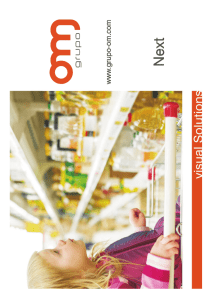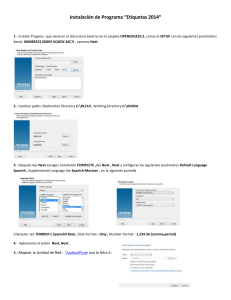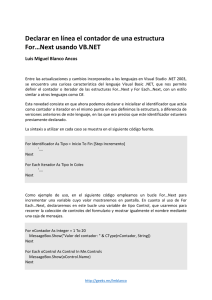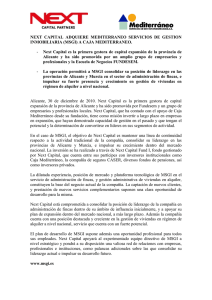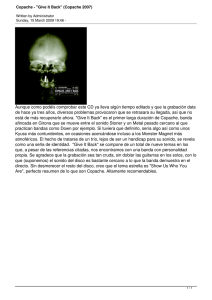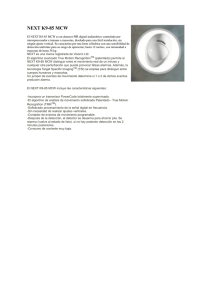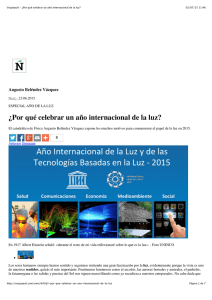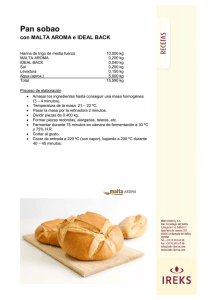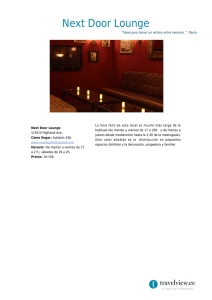Ciclo Nitrógeno y Fósforo en Suelos: Dinámica y Microbiología
Anuncio
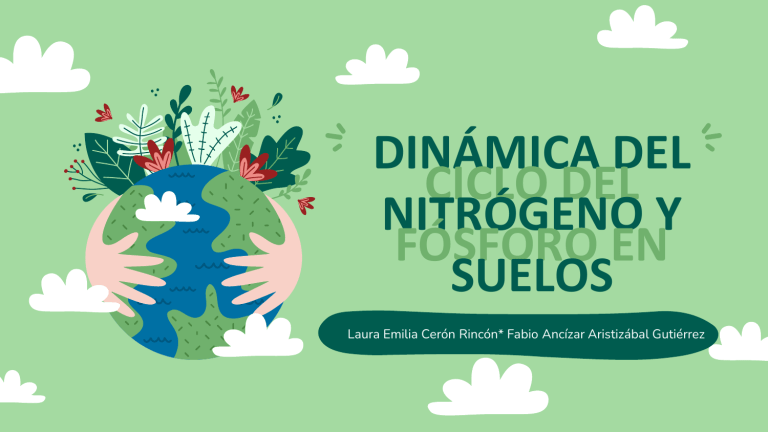
DINÁMICA DEL CICLO DEL NITRÓGENO Y FÓSFORO EN SUELOS Laura Emilia Cerón Rincón* Fabio Ancízar Aristizábal Gutiérrez INTRODUCCIÓN ❑Los ciclos biogeoquímicos del fósforo (P) y del nitrógeno (N) son sistemas dinámicos que suceden a través de la biosfera, de cuyos mecanismos de transformación depende la disponibilidad de estos elementos para diferentes formas de vida. Se acepta que la diversidad y actividad de las poblaciones microbianas posee un papel crucial en la dinámica de los nutrientes y por tanto el desafío está en comprender, como responden a las condiciones ambientales. La actividad microbiana en los suelos depende tanto de la condición del recurso y como de sus propiedades químicas, físicas y biológicas. ❑La productividad y dinámica de los ecosistemas terrestres está limitada a la disponibilidad de nutrientes. Para las plantas la disponibilidad de nitrógeno (N) es el principal limitante en la productividad de los cultivos, que junto con del fósforo (P) determinan el crecimiento vegetal. ❑Varios factores tienen influencia en la actividad microbiana de los suelos: los factores naturales: cambios climáticos, condiciones geográficas, profundidad, propiedades físicas, químicas y biológicas y los factores antropogénicos: contaminación y manejo agrícola. OBJETIVOS DE LA ECOLOGIA MICROBIANA Entre las principales metas de la ecología microbiana se plantea entender cómo los factores abióticos influyen en la abundancia, distribución de microorganismos y en los procesos que llevan a cabo. DINÁMICA DEL NITRÓGENO o En la biosfera comprende principalmente la fijación de nitrógeno (N2), la mineralización, la nitrificación, la desnitrificación y la oxidación anaeróbica del amonio. o El nitrógeno entra en la biosfera por fijación química y biológica del nitrógeno molecular (N2) y se remueve de la misma por desnitrificación. AUTORES ➢ Delgado y Salas (2006) proponen que la determinación cuantitativa de los diferentes compartimientos orgánicos y minerales, está relacionada con la disponibilidad de nutrientes y su susceptibilidad de alteración debido al manejo, sistemas de producción y procesos del suelo, donde estos compartimientos estén involucrados. ➢ Nannipieri y Eldor (2009) han propuesto que para interpretar los mecanismos y proponer modelos de la dinámica del nitrógeno, es necesario tener en cuenta las diferentes fracciones orgánicas o compartimentos, considerando que la temperatura, el tamaño de partícula de los residuos, la agregación, el tipo de suelo, la humedad, el secado y molido, el anegamiento y la anaerobiosis y los efectos vegetales, también tienen efectos sobre la dinámica del nitrógeno. AUTORES ➢ ➢ ➢ ➢ ➢ ➢ Antes del descubrimiento de proceso de Haber-Bosch (síntesis química de amoniaco) a principios del siglo XX, se consideraba que la fijación biológica de nitrógeno proporcionaba casi exclusivamente la entrada de este elemento en la biósfera. Se estima que la fijación biológica contribuye globalmente con 180 millones de toneladas métricas de amonio por año y que el aporte actual de nitrógeno antropogénico es comparable con el aporte biológico Los procesos de fijación los llevan a cabo gran variedad de bacterias que poseen nitrogenasas, enzimas que rompen el triple enlace del nitrógeno molecular y producen amonio. El estudio de los microorganismos implicados en dicho proceso en ambientes naturales, se utiliza como biomarcador el gen nifH que codifica la sub unidad hierro-proteína de la nitrogenasa, este biomarcador proporciona evidencias del potencial de proceso. Para los sistemas agrícolas la incorporación de nitrógeno es esencial para la fertilidad del suelo y por tanto para la productividad vegetal. No existe un consenso sobre los efectos de la fertilización orgánica o mineral a largo plazo sobre la diversidad diazótrofa en suelos negros (Tang, et al., 2012) Relaciones entre el ciclo del nitrógeno y los compartimentos orgánicos y minerales. DINÁMICA DEL FOSFORO o Proviene de las apatitas y depósitos defosfato natural. o Es liberado a través de procesos de meteorización o Liberado paulatinamente El FOSFORO ▪ ▪ ▪ ▪ ▪ ▪ ▪ ▪ El fósforo inorgánico (Pi) se presenta generalmente fuertemente fijado en forma de fosfatos de Ca2+, Fe2+, Mg2+ y Al3+,especialmente en arcillas del grupo de las caolinitas y ocluido en los óxidos de hierro y aluminio. El P, aplicado como fertilizante en forma de "superfosfato", puede fácilmente constituir compuestos inorgánicos inutilizables, debido a su inmovilización sobre la materia orgánica y arcillas. En mayoría fósforo de los ecosistemas terrestres se encuentra en el suelo. Su contenido varia entre 100 a 3000 mg de P/kg; entre un 15 y un 80% de dicho contenido está en formas orgánicas (Po). La principal fuente de compuestos orgánicos de fósforo (Po) la constituyen residuos de plantas, animales y microorganismos, que liberan compuestos como ácidos nucleicos, fosfolípidos y ésteres, y representa entre 3060% del P total. Las fuentes de fósforo y su distribución son críticas para la sostenibilidad de las prácticas agrícolas La principal contribución a la dinámica del fósforo en los suelos está dada por el recambio de los procesos de mineralización-inmovilización microbianos Los fosfatos de inositol son sintetizados por las plantas y son la forma dominante de la fracción orgánica (Po).El más importante es el fitato (myo-inositol hexakisfosfato) que puede llegar a ser el 80% del Po. Relaciones entre el ciclo del nitrógeno y los compartimentos orgánicos y minerales . Back Animal extinction: occurs when there are no more individuals of that species alive in the wild anywhere in the world. Sometimes it happens, for example, when humans invade their natural habitat Play! Games Extinct Animals Games Home Activities Extinct Animals Protecting World Animals Reusing Recycling Pollution Finished? Next Games Extinct Animals Click on the extinct animal Pinta Island Tortoise POlar Bear Next Pinta Island Tortoise Cause of Extinction: Destruction of their habitat by humans and also by hunting Back Polar Bear Not extinct yet. Climate change made them lost their habitat and be listed as a threatened species Next Back Games Extinct Animals Click on the extinct animal Flamingo West African Black Rhinoceros Next Next West African Black Rhinoceros Cause of Extinction: poaching has decimated this population and destroyed their habitat Back Flamingo Not extinct yet. Construction near to their habitat make them more accessible to land predators Next Back Games Extinct Animals Click on the extinct animal Spix’s Macaw Red Fox Next Next Spix’s Macaw Cause of Extinction: Went extinct in the wild due to habitat destruction, illegal trapping and trade Back Red Fox Not extinct yet. Adapts well to human areas such as farms, suburban areas and communities Next Back Games Scientists estimate that we humans share the planet with another 8.7 million different beings. In the world, currently 1.2 million species have been cataloged, which means more than 7 million remain unknown to science Play! World Animals Back Games World Animals Click on the continent to where these animal belongs Ready? Start now! Back North America Europe South America Asia Africa Oceania Toucan Next Next Toucan Mainly from tropical forests. Its oversized, colorful beak has made it one of the world's most popular birds Next Ooops! Try again! Back North America Europe South America Asia Africa Oceania Elephan t Next Next Elephant The African Elephants are the largest land animals on Earth. They play an important role in their ecosystem Next Ooops! Try again! Back North America Europe South America Asia Africa Oceania Kangaro o Next Next Kangaroo It lives in Australia's deserts and open grasslands, gathering in groups called mobs Next Ooops! Try again! Back Recycling is the process of converting recyclable materials into new ones and objects. It helps to reduce the pollution caused by waste Games Recycling Play! Back Games Recycling Remember: Recyclable materials are not trash. Practice home recycling, and separate the recyclable material at home Learn more! Back Plasti c Bottle Container Recycling Glass Bottle Glass jar Jam glass Paper Cardboard Magazine Newspaper Office paper Tetra Pak Carton Play! Metal Can Aluminum Back Recycling Click on the right container for this material Next Next Paper Decomposition: 2 week - 5 years Next Ooops! Try again! Back Recycling Click on the right container for this material Next Next Plastic Decomposition: more than 500 years Next Ooops! Try again! Back Recycling Click on the right container for this material Next Next Glass Decomposition: indeterminate Next Ooops! Try again! Back Recycling Click on the right container for this material Next Next Metal Decomposition: 50 - 100 years Next Ooops! Try again! Back The world produces about 300 million tons of plastic waste each year. Only 9% of the plastic waste generated is recycled Next Back Protecting Activities Small actions can help protect the environment from being damaged. We should take care of our planet as it’s our home Help to protect! Back Protecting Activities Think about what we could do together to protect the environment and draw these actions Let’s think together! Back Protecting Help to clean the beach Next Back Reusing Activities Reusing and giving a new purpose to old materials is one of the best ways to help the environment Let’s learn more! Back Reusing Activities Bird Box House You can use any paper or card box you have at home Let’s make it! Back Reusing You will need: ● ● ● ● ● Paper/card box Pencil Scissors String Dry straw 1 3 2 4 Next Back Activitie s Pollution Pollution is a global problem. Water and air pollution are the biggest causes of global warming. Pollution in general can cause human diseases Let’s learn more! Back Air Pollution Activities To modify this graph, click on it, follow the link, change the data and paste the new graph here ppm - parts per million (each million molecules of air has the amount of CO₂) Next Back Water Pollution Activities To modify this graph, click on it, follow the link, change the data and paste the new graph here 35% Synthetic fabric 28% Tire 24% Urban pollution 7% Road paints 4% Ship hull paints Where do microplastics in the ocean come from? Next Back Pollution Actvities Think about how our actions could stop pollution and finish the following list. Write it down and hang it where you can see it Let’s do this list! Back Pollution Water Pollution Do not throw trash on the street Air Pollution Choose walking over cars Next Back Well Done! Next Thank s Every small action counts. Let’s protect the environment together! CREDITS: This presentation template was created by Slidesgo, including icons by Flaticon and infographics & images by Freepik. Please keep this slide for attribution. Resources Vector ● ● ● ● ● ● ● ● ● Save the planet concept Tropical flowers with leaves isolated on white background Hand-drawn abstract organic shapes wallpaper style Pack with four decorative animals Hand drawn tropical animal collection African animals and wild birds banners Flat recycling landing page template Recycling landing page template Save the planet illustration design ● ● ● ● ● Set of cardboard boxes to shipping Diy creative workshop illustration Flat recycling landing page template People cleaning beach Hand drawn ecology badges Photos ● ● Cute young girl recycling together Close-up young boys drawing recycle sign on whiteboard Alternative Resources Instructions for use In order to use this template, you must credit Slidesgo by keeping the Thanks slide. You are allowed to: - Modify this template. - Use it for both personal and commercial projects. You are not allowed to: - Sublicense, sell or rent any of Slidesgo Content (or a modified version of Slidesgo Content). - Distribute Slidesgo Content unless it has been expressly authorized by Slidesgo. - Include Slidesgo Content in an online or offline database or file. - Offer Slidesgo templates (or modified versions of Slidesgo templates) for download. - Acquire the copyright of Slidesgo Content. For more information about editing slides, please read our FAQs or visit Slidesgo School: https://slidesgo.com/faqs and https://slidesgo.com/slidesgo-school Fonts & colors used This presentation has been made using the following fonts: Nanum Pen Script (https://fonts.google.com/specimen/Nanum+Pen+Script) Nunito (https://fonts.google.com/specimen/Nunito) #e5ffeb #a4daa1 #70b16d #005c4f #992020 #ed8b85 #ffaa20 #ffd966 #0070a4 #ffffff Stories by Freepik Create your Story with our illustrated concepts. Choose the style you like the most, edit its colors, pick the background and layers you want to show and bring them to life with the animator panel! It will boost your presentation. Check out How it Works. Pana Amico Bro Rafiki Use our editable graphic resources... You can easily resize these resources without losing quality. To change the color, just ungroup the resource and click on the object you want to change. Then, click on the paint bucket and select the color you want. Group the resource again when you’re done. JANUARY FEBRUARY MARCH APRIL MAY JUNE PHASE 1 Task 1 Task 2 PHASE 2 Task 1 Task 2 JANUARY PHASE 1 Task 1 Task 2 FEBRUARY MARCH APRIL ...and our sets of editable icons You can resize these icons without losing quality. You can change the stroke and fill color; just select the icon and click on the paint bucket/pen. In Google Slides, you can also use Flaticon’s extension, allowing you to customize and add even more icons. Educational Icons Medical Icons Business Icons Teamwork Icons Help & Support Icons Avatar Icons Creative Process Icons Performing Arts Icons Nature Icons SEO & Marketing Icons
